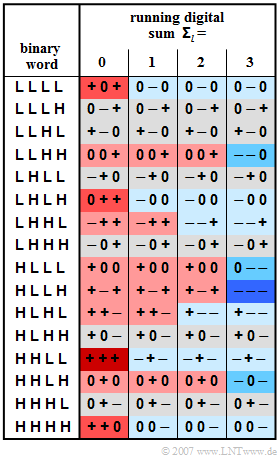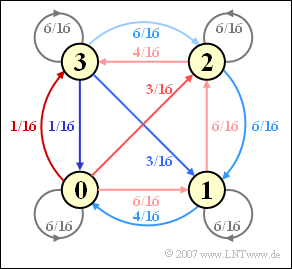Difference between revisions of "Aufgaben:Exercise 1.4Z: Modified MS43 Code"
| (2 intermediate revisions by the same user not shown) | |||
| Line 3: | Line 3: | ||
}} | }} | ||
| − | [[File: | + | [[File:EN_Bei_Z_1_4.png|right|frame|Code table of the MMS43 code]] |
For ISDN data transmission, the MMS43 code is used in Germany and Belgium on the so-called "$\rm U_{\rm K0}$" interface $($transmission path between the exchange and the NTBA$)$. | For ISDN data transmission, the MMS43 code is used in Germany and Belgium on the so-called "$\rm U_{\rm K0}$" interface $($transmission path between the exchange and the NTBA$)$. | ||
| Line 39: | Line 39: | ||
|type="[]"} | |type="[]"} | ||
- 4B3T is in principle better than the redundancy-free binary code. | - 4B3T is in principle better than the redundancy-free binary code. | ||
| − | + The transmitted signal should be free of DC | + | + The transmitted signal should be free of DC signals if the channel frequency response $H_{\rm K}(f = 0) = 0$. |
+ A small symbol rate $(1/T)$ allows a longer cable length. | + A small symbol rate $(1/T)$ allows a longer cable length. | ||
| Line 63: | Line 63: | ||
{{ML-Kopf}} | {{ML-Kopf}} | ||
| − | '''(1)''' <u>Statements 2 and 3</u> are correct: | + | '''(1)''' <u>Statements 2 and 3</u> are correct: |
| − | *The first statement is not true: For example, the AWGN channel (additive white Gaussian noise) with a 4B3T code results in a much larger error probability due to the ternary decision compared to the redundancy-free binary code | + | *The first statement is not true: For example, the AWGN channel ("additive white Gaussian noise") with a 4B3T code results in a much larger error probability due to the ternary decision compared to the redundancy-free binary code. |
| − | |||
| − | |||
| − | |||
| + | *The essential reason for the use of a redundant transmission code is rather that no DC signal component can be transmitted via a "telephone channel". | ||
| + | *The $25 \%$ smaller symbol rate $(1/T)$ of the 4B3T code also accommodates the transmission characteristics of copper lines (strong increase in attenuation with frequency). | ||
| − | '''(2)''' With the initial value ${\it \Sigma}_{0} = 0$, the 4B3T coding results in: | + | *For a given line attenuation, therefore, a greater length can be bridged with the 4B3T code than with a redundancy-free binary signal. |
| + | |||
| + | |||
| + | |||
| + | '''(2)''' With the initial value ${\it \Sigma}_{0} = 0$, the 4B3T coding results in: | ||
* '''1100''' ⇒ "+ + +" ⇒ ${\it \Sigma}_{1} = 3$, | * '''1100''' ⇒ "+ + +" ⇒ ${\it \Sigma}_{1} = 3$, | ||
| Line 82: | Line 85: | ||
| − | Thus, the amplitude coefficient we are looking for is $a_{12}\hspace{0.15cm} \underline{ = \ –1}$. | + | Thus, the amplitude coefficient we are looking for is $a_{12}\hspace{0.15cm} \underline{ = \ –1}$. |
[[File:P_ID1341_Dig_A_2_6c.png|right|frame|Markov diagram for the MMS43 code]] | [[File:P_ID1341_Dig_A_2_6c.png|right|frame|Markov diagram for the MMS43 code]] | ||
| − | '''(3)''' From the coloring of the given code table, one can determine the following Markov diagram. | + | '''(3)''' From the coloring of the given code table, one can determine the following Markov diagram. |
| − | *From it, the transition probabilities we are looking for can be read: | + | *From it, the transition probabilities we are looking for can be read: |
:$${\rm Pr}({\it \Sigma}_{l+1} = 0 \ | \ {\it \Sigma}_{l}=0) \ = \ 6/16 \underline{ \ = \ 0.375},$$ | :$${\rm Pr}({\it \Sigma}_{l+1} = 0 \ | \ {\it \Sigma}_{l}=0) \ = \ 6/16 \underline{ \ = \ 0.375},$$ | ||
| Line 96: | Line 99: | ||
| − | '''(4)''' <u>Statements 2 and 3</u> are correct: | + | '''(4)''' <u>Statements 2 and 3</u> are correct: |
| − | *The first statement is false, which can be seen from the asymmetries in the Markov diagram. | + | *The first statement is false, which can be seen from the asymmetries in the Markov diagram. |
| − | *On the other hand, there are symmetries with respect to the states "0" and "3" and between "1" and "2". | + | |
| + | *On the other hand, there are symmetries with respect to the states "0" and "3" and between "1" and "2". | ||
| − | In the following calculation, instead of ${\rm Pr}({\it \Sigma}_{l} = 0)$, we write ${\rm Pr}(0)$ in a simplified way. Taking advantage of the | + | In the following calculation, instead of ${\rm Pr}({\it \Sigma}_{l} = 0)$, we write ${\rm Pr}(0)$ in a simplified way. |
| + | * Taking advantage of the properties ${\rm Pr}(3) = {\rm Pr}(0)$ and ${\rm Pr}(2) = {\rm Pr}(1)$, we get the following equations from the Markov diagram: | ||
:$${\rm Pr}(0)= \frac{6}{16} \cdot {\rm Pr}(0) + \frac{4}{16} \cdot {\rm Pr}(1)+ \frac{1}{16} \cdot {\rm Pr}(3)\hspace{0.3cm} \Rightarrow \hspace{0.3cm}\frac{9}{16} \cdot {\rm Pr}(0)= \frac{4}{16} \cdot {\rm Pr}(1).$$ | :$${\rm Pr}(0)= \frac{6}{16} \cdot {\rm Pr}(0) + \frac{4}{16} \cdot {\rm Pr}(1)+ \frac{1}{16} \cdot {\rm Pr}(3)\hspace{0.3cm} \Rightarrow \hspace{0.3cm}\frac{9}{16} \cdot {\rm Pr}(0)= \frac{4}{16} \cdot {\rm Pr}(1).$$ | ||
| − | From the further condition ${\rm Pr}(0) + {\rm Pr}(1) = 1/2$ | + | *From the further condition ${\rm Pr}(0) + {\rm Pr}(1) = 1/2$ follows further: |
:$${\rm Pr}(0)= {\rm Pr}(3)= \frac{9}{26}\hspace{0.05cm}, \hspace{0.2cm} {\rm Pr}(1)= {\rm Pr}(2)= \frac{4}{26}\hspace{0.05cm}.$$ | :$${\rm Pr}(0)= {\rm Pr}(3)= \frac{9}{26}\hspace{0.05cm}, \hspace{0.2cm} {\rm Pr}(1)= {\rm Pr}(2)= \frac{4}{26}\hspace{0.05cm}.$$ | ||
| − | This calculation is based on the <u>sum of the incoming arrows in the "0" condition</u>. | + | :This calculation is based on the <u>sum of the incoming arrows in the "0" condition</u>. |
| − | One could also give equations for the other three states, but they all give the same result: | + | *One could also give equations for the other three states, but they all give the same result: |
:$${\rm Pr}(1) \ = \ \frac{6}{16} \cdot {\rm Pr}(0) + \frac{6}{16} \cdot {\rm Pr}(1)+ \frac{6}{16} \cdot {\rm Pr}(2)+\frac{3}{16} \cdot {\rm Pr}(3)\hspace{0.05cm},$$ | :$${\rm Pr}(1) \ = \ \frac{6}{16} \cdot {\rm Pr}(0) + \frac{6}{16} \cdot {\rm Pr}(1)+ \frac{6}{16} \cdot {\rm Pr}(2)+\frac{3}{16} \cdot {\rm Pr}(3)\hspace{0.05cm},$$ | ||
:$$ {\rm Pr}(2) \ = \ \frac{3}{16} \cdot {\rm Pr}(0) + \frac{6}{16} \cdot {\rm Pr}(1)+ \frac{6}{16} \cdot {\rm Pr}(2)+\frac{6}{16} \cdot {\rm Pr}(3)\hspace{0.05cm},$$ | :$$ {\rm Pr}(2) \ = \ \frac{3}{16} \cdot {\rm Pr}(0) + \frac{6}{16} \cdot {\rm Pr}(1)+ \frac{6}{16} \cdot {\rm Pr}(2)+\frac{6}{16} \cdot {\rm Pr}(3)\hspace{0.05cm},$$ | ||
Latest revision as of 16:55, 24 October 2022
For ISDN data transmission, the MMS43 code is used in Germany and Belgium on the so-called "$\rm U_{\rm K0}$" interface $($transmission path between the exchange and the NTBA$)$.
The abbreviation "MMS43" stands for "Modified Monitored Sum 4B3T".
This is a 4B3T block code with the four code tables shown in the graphic, which are used for coding according to the so-called "running digital sum" $($after $l$ blocks$)$:
- $${\it \Sigma}\hspace{0.05cm}_l = \sum_{\nu = 1}^{3 \hspace{0.05cm}\cdot \hspace{0.05cm} l}\hspace{0.02cm} a_\nu$$
For initialization: ${\it \Sigma}_{0} = 0$ is used.
The colorings in the graph mean:
- If the running digital sum does not change $({\it \Sigma}\hspace{0.05cm}_{l+1} = {\it \Sigma}\hspace{0.05cm} _{l})$, a field is grayed out.
- An increase $({\it \Sigma}\hspace{0.05cm}_{l+1} > {\it \Sigma}\hspace{0.05cm}_{l})$ is highlighted in red, a decrease $({\it \Sigma}\hspace{0.05cm}_{l+1} < {\it \Sigma}\hspace{0.05cm} _{l})$ in blue.
- The more intense these colors are, the greater the change in the running digital sum.
Notes:
- The exercise belongs to the chapter "ISDN Basic Access".
- Information about the MMS43 code can be found in the chapter "Block Coding with 4B3T Codes" of the book "Digital signal transmission".
Questions
Solution
(1) Statements 2 and 3 are correct:
- The first statement is not true: For example, the AWGN channel ("additive white Gaussian noise") with a 4B3T code results in a much larger error probability due to the ternary decision compared to the redundancy-free binary code.
- The essential reason for the use of a redundant transmission code is rather that no DC signal component can be transmitted via a "telephone channel".
- The $25 \%$ smaller symbol rate $(1/T)$ of the 4B3T code also accommodates the transmission characteristics of copper lines (strong increase in attenuation with frequency).
- For a given line attenuation, therefore, a greater length can be bridged with the 4B3T code than with a redundancy-free binary signal.
(2) With the initial value ${\it \Sigma}_{0} = 0$, the 4B3T coding results in:
- 1100 ⇒ "+ + +" ⇒ ${\it \Sigma}_{1} = 3$,
- 0100 ⇒ " – + 0" ⇒ ${\it \Sigma}_{2} = 3$,
- 0110 ⇒ "– – +" ⇒ ${\it \Sigma}_{3} = 2$,
- 1010 ⇒ "+ – –" ⇒ ${\it \Sigma}_{4} = 1$.
Thus, the amplitude coefficient we are looking for is $a_{12}\hspace{0.15cm} \underline{ = \ –1}$.
(3) From the coloring of the given code table, one can determine the following Markov diagram.
- From it, the transition probabilities we are looking for can be read:
- $${\rm Pr}({\it \Sigma}_{l+1} = 0 \ | \ {\it \Sigma}_{l}=0) \ = \ 6/16 \underline{ \ = \ 0.375},$$
- $${\rm Pr}({\it \Sigma}_{l+1} = 2 \ | \ {\it \Sigma}_{l}=0) \ = \ 3/16 \underline{ \ = \ 0.1875},$$
- $${\rm Pr}({\it \Sigma}_{l+1} = 0 \ | \ {\it \Sigma}_{l}=2) \underline{ \ = \ 0}.$$
(4) Statements 2 and 3 are correct:
- The first statement is false, which can be seen from the asymmetries in the Markov diagram.
- On the other hand, there are symmetries with respect to the states "0" and "3" and between "1" and "2".
In the following calculation, instead of ${\rm Pr}({\it \Sigma}_{l} = 0)$, we write ${\rm Pr}(0)$ in a simplified way.
- Taking advantage of the properties ${\rm Pr}(3) = {\rm Pr}(0)$ and ${\rm Pr}(2) = {\rm Pr}(1)$, we get the following equations from the Markov diagram:
- $${\rm Pr}(0)= \frac{6}{16} \cdot {\rm Pr}(0) + \frac{4}{16} \cdot {\rm Pr}(1)+ \frac{1}{16} \cdot {\rm Pr}(3)\hspace{0.3cm} \Rightarrow \hspace{0.3cm}\frac{9}{16} \cdot {\rm Pr}(0)= \frac{4}{16} \cdot {\rm Pr}(1).$$
- From the further condition ${\rm Pr}(0) + {\rm Pr}(1) = 1/2$ follows further:
- $${\rm Pr}(0)= {\rm Pr}(3)= \frac{9}{26}\hspace{0.05cm}, \hspace{0.2cm} {\rm Pr}(1)= {\rm Pr}(2)= \frac{4}{26}\hspace{0.05cm}.$$
- This calculation is based on the sum of the incoming arrows in the "0" condition.
- One could also give equations for the other three states, but they all give the same result:
- $${\rm Pr}(1) \ = \ \frac{6}{16} \cdot {\rm Pr}(0) + \frac{6}{16} \cdot {\rm Pr}(1)+ \frac{6}{16} \cdot {\rm Pr}(2)+\frac{3}{16} \cdot {\rm Pr}(3)\hspace{0.05cm},$$
- $$ {\rm Pr}(2) \ = \ \frac{3}{16} \cdot {\rm Pr}(0) + \frac{6}{16} \cdot {\rm Pr}(1)+ \frac{6}{16} \cdot {\rm Pr}(2)+\frac{6}{16} \cdot {\rm Pr}(3)\hspace{0.05cm},$$
- $$ {\rm Pr}(3) \ = \ \frac{1}{16} \cdot {\rm Pr}(0) + \frac{4}{16} \cdot {\rm Pr}(2)+\frac{6}{16} \cdot {\rm Pr}(3)\hspace{0.05cm}.$$

